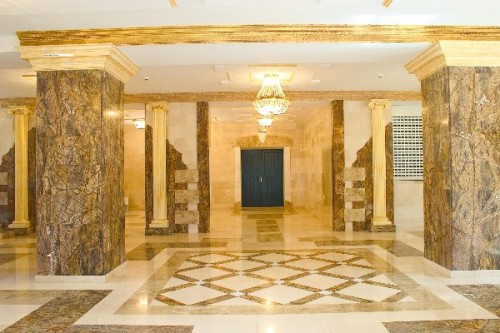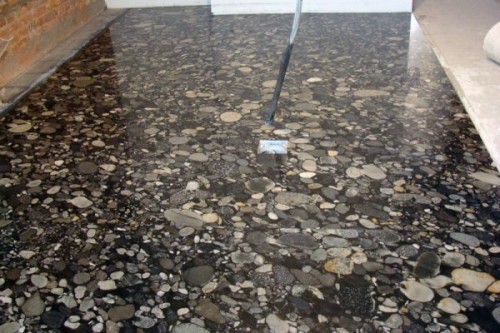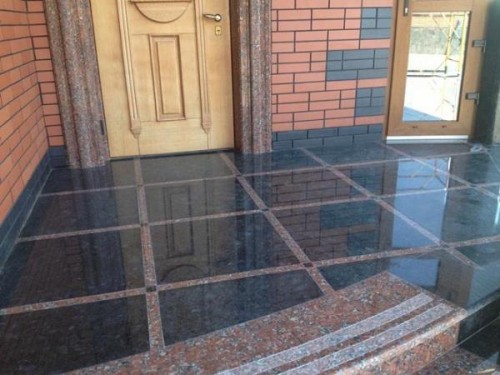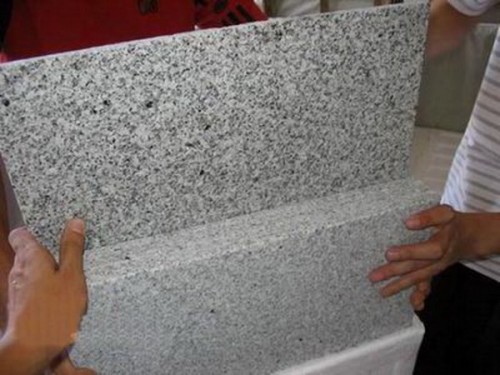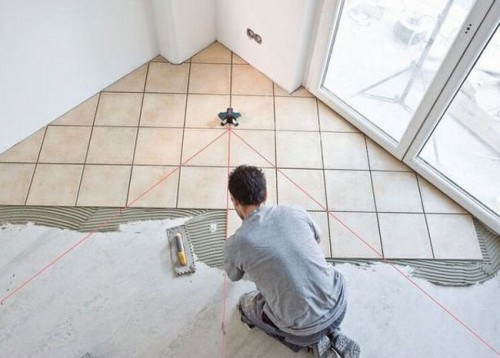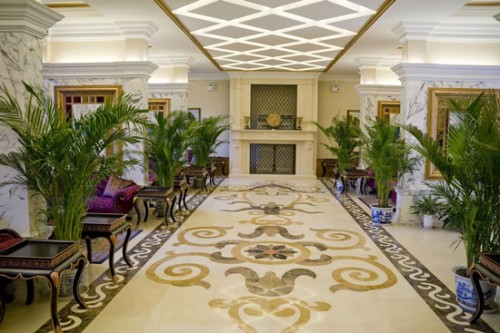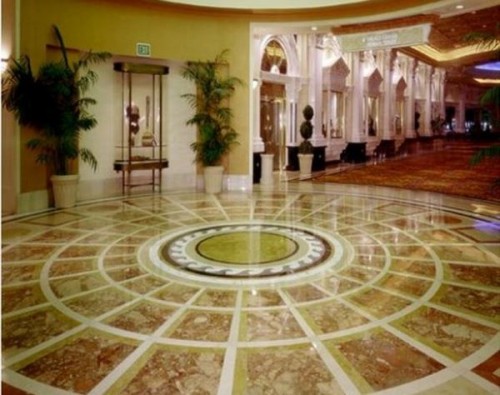Special requirements are imposed on the flooring of some rooms. In these cases, not the beauty of the interior plays a large role, but such qualities as the life, wear resistance and ease of use. So, the material that has all the above characteristics is natural granite. It is characterized by high strength, practicality, durability.
Content
Characteristics of the material
Granite does not lose its appearance under the influence of time, sunlight, moisture. He is able to take out sharp and frequent temperature fluctuations. Unlike granite, ceramic tiles have a shorter service life. Therefore, it is granite that can be considered one of the best materials for flooring.
True, it is not appropriate to lay it everywhere. So, it is most suitable for the floor of the kitchen, the living room, the bathroom in large houses, the verandas, the porch, the garage, the garden and park gazebo or the pool. Today, you can often find floors from granite in the subway and shopping centers.
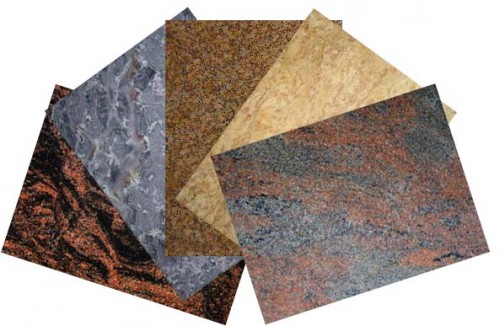
Distinctive features of granite:
- Reliability and durability.
- The price of one square meter of granite today is from 35 to 200 dollars, and the cost of the same amount of tile is 8-60 dollars.
- One square meter of granite 20 millimeters thick weighs 53 kilograms, and the same amount of ceramic tiles is only 15 kilograms.
- Granite is a natural stone, and its pattern, color and granularity can be different, which is achieved naturally. A ceramic tile is a facing material created artificially.
- Granite floor tiles can have a different length, thickness and width. This should be taken into account when laying. High -quality ceramic tiles always have the same size. Therefore, working with her is easier.
- Since granite tiles are natural material, the assortment of its shades and color is limited. Ceramic tiles created in an artificial way, on the contrary, have an abundance of drawings and colors.
- For porcelain border, the service life is almost unlimited, unlike ceramic tiles, which serves no more than 60 years.
- Granite has a high strength and a small percentage of wear - only about 0.1 millimeters are abrasion per year. Moreover, at least one million people must go through this floor for this floor. Under the same conditions, ceramic tiles over the year have been hysterical from 0.15 to 0.40 millimeters.
- The strength of granite tiles is 552.7–604.6 kg/cm2, and ceramic tiles - 280–435 kg/cm2.
How to choose a ceramic granite for the floor
Granite is a rock, which is mined at a depth of several kilometers in underground mines. The raw materials look like huge fragments, from which huge blocks of rectangular shape are then cut. Then these blocks are cut into granite slaves 1.5 meters long, 0.35-1.25 meters wide and 20-35 millimeters thick. They are laid out on windows in stores.
Often, by mistake, granite is called gabbro and labradotir. These natural stones are similar in terms of properties and appearance to granite. But the labradotir, due to some minerals that make up it, does not tolerate the environment. For this reason, it is not used for outdoor decoration. Gabbro has a plain black color and a polished surface. Therefore, it is used to decorate the interior and manufacture of monuments.
Granite must be able to choose. For this, some points should be taken into account. Here are the most important of them:
- In different places of production, granite has a unique natural color. Therefore, in two different quarries, the material of one shade cannot be obtained.
- Granite tile is usually cut to order in a special workshop. Most often, tiles are ordered with a size of 600 by 600 and 300 by 600 with a thickness of 20-30 millimeters. To cut granite slab, special machines are required. Therefore, it will not work to cut the material on your own.
- An important point: the larger the size of the tile, the more beautiful the floor will look, but this, in turn, complicates its styling. There are two reasons for this:
- large weight, because of which it can easily break in half;
- it is more difficult to withstand the level.
It is worthwhile to know that the thickness of the selected granite tile should depend on the loads on the floor and on the characteristics of the room itself.
When choosing granite, it is also worth remembering that there are three types of stone processing:
- Polished.
- Hard.
- Thermal -processed.
Characteristics:
- Polished tiles have a mirror surface. This type of processing is considered the most beautiful and at the same time very slippery. At the same time, it is easiest to scratch.
- Plotted granite tiles has a surface on which a natural pattern is visible, but unlike a polished one does not shine at all.
- The heat -processed tiles were subject to processing with a stream of gas of high temperature. After that, it becomes rough and has no shine.
All parameters that were listed above, to one degree or another, affect the cost of this tile. When choosing, you should ask about the field of your favorite sample and whether it is available in the store’s warehouse. Rare varieties of granite for the floor will be more expensive. The price of one square meter of slab also depends on its thickness and area. The thicker the tile, the more it will be more expensive.
The average prices for granite tiles are from 35 to 200 dollars per square meter. Expensive samples can cost up to $ 500. Attentiveness and caution when choosing will help you do not get into the deception of unscrupulous sellers. After all, sometimes a simple granite is given out in the quarries of Russia, with a rare and expensive Italian. Polished material usually has a higher price than heat -treated.
Of course, granite tiles are better suited for floor cladding than ceramic. Granite floor will last noticeably longer and will be able to withstand heavy loads. True, when facing the floor, granite must be taken into account the size, weight and color of the material. If all this is taken into account, then your efforts will be sure to be crowned with success. Granite tile requires a completely different approach when working with it, but it's worth it.
Necessary tool for working with granite
In order to make a gender of granite, you will need a special construction tool. After all, this material is very durable. Therefore, it will not work to cut it with a tile cutter. For work, for example, you will need a grinder or Ushm. It should be powerful enough. It will also need a stone cutting disk. With the help of a grinder, some slices will be made on granite tiles. However, it is difficult to achieve good quality when cutting Ushm.
In addition to the grinder, the following tools will be needed for work:
- Construction level.
- Trowel.
- Rubber spatula.
- Rubber kiyanka.
- Mixer for construction work.
- Lighthouse threads.
- Bucket.
- Pieces of tiles for lighthouses.
- To calculate the laying of granite plates, you will need a long ruler, roulette and a large square.
Nuances of working with granite
- Granite tile is not placed like ceramic. Therefore, before proceeding with the lining of the floor, you need to know several rules for working with this material.
- The granite is laid in the end, and not with the seams, like ceramic tiles.
- Before starting work on laying, you need to level the floor, for this it is necessary to make its screed.
- Do not forget that granite tiles can have different thicknesses. In order to press the protruding parts, you should use a thick layer of glue or solution.
- This material can be of different sizes. Therefore, you can not put such a tile diagonally or seam into a seam. It is best to launch a run and at the same time observe the drawing.
- Tiles can be cut from different slabs. Therefore, it differs in shade. To solve this problem, you should remember the following:
- in no case do not lay the tile behind the tiles from one package;
- before starting work, it is necessary to put all the material from all packages to identify tiles of different colors or a possible marriage;
- if there are defects on some tiles, then it is best to put them in inconspicuous areas. Material without defects must be placed in a chaotic manner in order to evenly distribute tiles of different colors on the floor. So they will be less striking.
Surface preparation
Granite tiles are much thicker than ceramic. Therefore, before laying, be sure to measure the height of the threshold. Granite requires at least 40-50 millimeters. In addition, be sure to remove garbage and dust from the floor. You can cover it with a primer.
Calculations for laying and cutting
Granite tiles are usually lined with one of the end walls, from left to right. At the same time, it is important to know with which tiles to start: either with the whole, or with half or with one third. It all depends on the area of \u200b\u200bthe room and the size of the material. In any case, you need to use the method "into a run".
The calculation of the floor level
- When performing the screed and installation of doors, you need to leave a level of 40 millimeters. To determine the floor level, you should install in the corners of the beacon. As them, you can use levels over long distances.
- From each beach you need to pull around the perimeter and the diagonals of the room of the thread.
- You can often see that some corners have an unreleased level. If the angle of the room is deviated, no more than 60 millimeters can be added to these places even more solution. If the level in some area, on the contrary, is higher than necessary, then you can put granite on glue, and not on the solution.
- In addition to corners, you also need to check the quality of the floor along all threads of the beacons.
Laying granite on the floor
There are three types of laying of granite tiles in total:
- Per solution.
- On glue.
- On the equipped metal frame.
On the floor, this material is usually laid in the first or second method. On vertical surfaces, the tile is lined on a metal frame. Different solutions have different prices. The cheapest option is Portland cement, diluted with water with slaked lime and sand (mainly river). Glue will cost more than the solution. At the same time, its consumption will be greater.
Work technology:
- It is important to properly put the first row of tiles. Because it is to him that the rest of the material will be attached. For the first and last row, the beacons will be directly the tiles themselves. To do this, the thread from the left and right angles is bandaged on two tiles, which were laid at the beginning and end without solution.
- The solution must be applied to the floor with a trowel. Then the tile is laid on it, after which it is tapped with a rubber clay, while following the threads of the beacons.
- It is important that there are no voids under the tiles. You need to carefully monitor this. The rest of the material is laid in the same way. It remains to plant only the first and last tiles in the row, which, so far, play the role of the beacons. Remove the threads from them and then put them on the solution.
- When installing the next row, you must first install lighthouse plates and tie the threads to them. In order not to knock down the drawing, it is important to remember what plate you started the previous row. Some beacons are not enough to check the evenness of the masonry. Therefore, you need to control it using the level.
- In exactly the same way, masonry of the remaining rows of tiles should be laid. If a defect appears on the tile or a mistake occurs, then it will be possible to get it and replace it with another only within a day. In the future, it will be impossible to do.
- Each time you go to a new row, you need to rinse the tiles from the solution with a damp cloth. You should not be afraid to pour too much water between tiles. Masonry is only good.
- There are no restrictions with horizontal masonry. If desired, you can immediately lay the entire surface of the floor. Only after work it will be necessary to wait for about two days before you can walk along it.
- Almost always after drying between the plates, cracks form, which should be wiped with grouting to the color of the stone. It should be selected depending on the characteristics of the room. It is moisture -resistant, frost -resistant and especially strong.
The final finish
In order to give granite after laying an attractive appearance, you can use the paste with silicone or liquid wax. This is possible to do, both with the help of a polishing machine, and manually using felt or felt.
Granite in its strength is not inferior to any building material. It is so practical that if there is a need, then you can easily put a new one in place of the old. Over time, such a tile does not lose its appearance, its qualitative characteristics also do not suffer. A weak point in the masonry is a solution that can collapse over time. Therefore, often granite plates are removed and cleaned of the old solution and laid on a new one. In this, he fully pays for all the costs of its acquisition and styling.
Granite floors - photo

